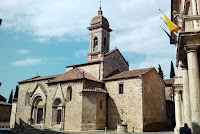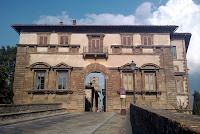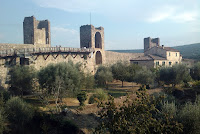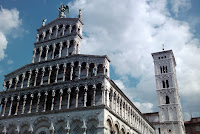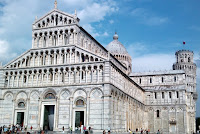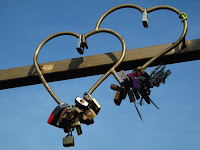
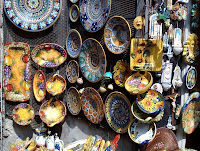 Leaving Tuscany we moved east into Umbria for even more hilltop towns, stopping first at Orvieto to see the Duomo with reportedly the most striking facade in Italy, Why is such a grand church tucked away in such an obscure location? For the same reason that many grand churches exist in odd locations; a 'miracle' occurred in the dim and distant past.
Leaving Tuscany we moved east into Umbria for even more hilltop towns, stopping first at Orvieto to see the Duomo with reportedly the most striking facade in Italy, Why is such a grand church tucked away in such an obscure location? For the same reason that many grand churches exist in odd locations; a 'miracle' occurred in the dim and distant past. Not far away is the tiny little hilltop village of Civata, which is getting smaller all the time as the cliffs around it slowly erode. Just inside the gate is a grand facade that has nothing at all behind it, the villa having slipped down the cliff some years ago.
Not far away is the tiny little hilltop village of Civata, which is getting smaller all the time as the cliffs around it slowly erode. Just inside the gate is a grand facade that has nothing at all behind it, the villa having slipped down the cliff some years ago.
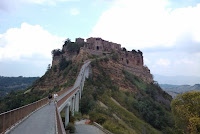
Likewise the access path disappeared and the village is now accessible on foot only across a bridge from the neighbouring town. The are very few permanent residents left but some of them run the most fascinating restaurant, the food is cooked over an open fire and the preparation rooms are really just alcoves off the main dining area.
 We had just crossed the long bridge and got back to the car when the rain came lashing down so there was no sightseeing to be done in Bagnoregio, we just drove on to Todi which unfortunately did not live up to its description in the guide book. (but the cappuccino was fabulous)
We had just crossed the long bridge and got back to the car when the rain came lashing down so there was no sightseeing to be done in Bagnoregio, we just drove on to Todi which unfortunately did not live up to its description in the guide book. (but the cappuccino was fabulous)Heading in the general direction of Assisi, we stopped off at Deruta, home of 'the best ceramics in Italy'
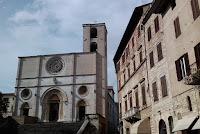 and had a browse though a number of the workshop/showrooms, eventually leaving with a piece we hope will fit in our hand-luggage.
and had a browse though a number of the workshop/showrooms, eventually leaving with a piece we hope will fit in our hand-luggage.Our 4-month old Canon Powershot G10 died suddenly leaving us with inferior quality photos





